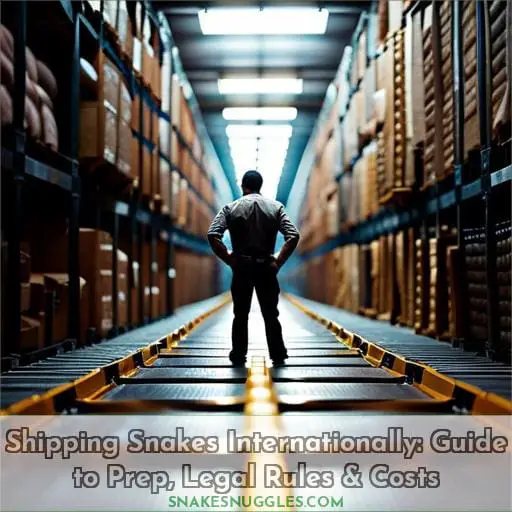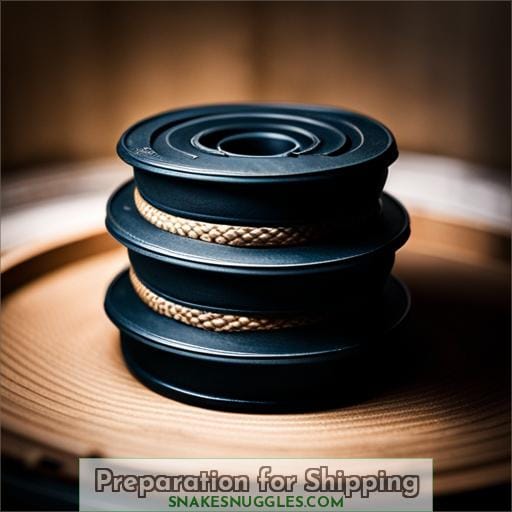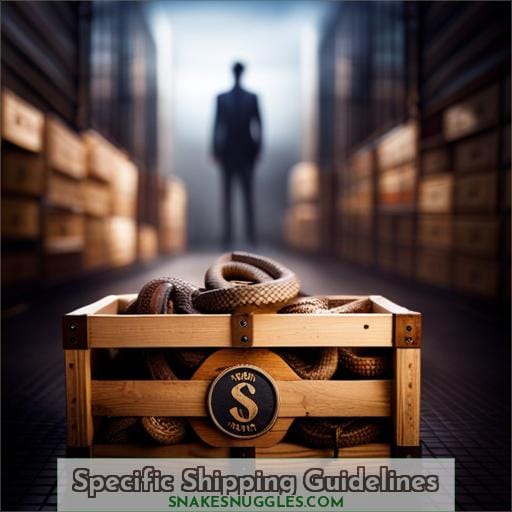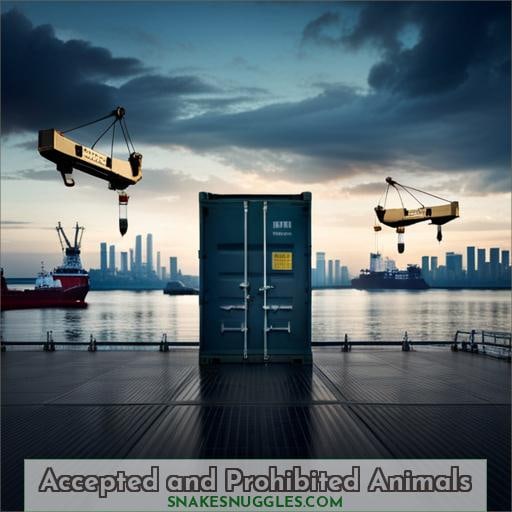This site is supported by our readers. We may earn a commission, at no cost to you, if you purchase through links.
 Navigating the world of international shipping for snakes can seem intimidating. But with a bit of preparation and research, you can successfully ship your reptiles abroad!
Navigating the world of international shipping for snakes can seem intimidating. But with a bit of preparation and research, you can successfully ship your reptiles abroad!
The first step is to choose a strong and secure box that has 1-2 small breathing holes. Insulate it with materials like Styrofoam, line it with a breathable fabric pouch or tub for the snake, and label it ‘Handle With Care’ and ‘Fragile’.
Then, pick an appropriate shipping company known for its compliance standards. It’s also essential to understand legal requirements related to wildlife trade laws in both your country as well as the destination country – which may include obtaining permits such as CITES (Convention on International Trade in Endangered Species).
You’ll likely need fast shipping services, so be sure to consider companies like Reptile Express and Ship Your Reptiles who specialize in reptilian shipments specifically.
Finally, familiarize yourself with package marking/labeling guidelines along accepted animals list.
Shipping snakes internationally doesn’t have to be daunting when done right – just follow these steps carefully and enjoy the safe arrival of your beloved scaly friends at their new home soon enough!
Table Of Contents
- Key Takeaways
- Preparation for Shipping
- Legal Considerations
- Shipping Logistics
- Specific Shipping Guidelines
- International Live Animal Shipping
- Checking the Accepted Live Animals List
- Utilizing the International Special Commodities Contract
- Ensuring Humane Care and Safety During Transportation
- Following Guidelines for Package Marking and Labeling
- Being Aware of Restrictions in Certain Regions (e.g., Hawaii)
- Knowing That Prohibited Items Are Disposed of en Route
- Packaging and Container Guidelines
- Accepted and Prohibited Animals
- Shipping Costs
- Safety of Shipping Reptiles
- Laws on Shipping Snakes Internationally
- Frequently Asked Questions (FAQs)
- Conclusion
Key Takeaways
- Prepare a sturdy box with 1-2 breathing holes.
- Insulate the box using materials like Styrofoam.
- Use a reputable shipping company that follows regulations.
- Research the legal requirements of the destination country.
Preparation for Shipping
When shipping a snake internationally, it is important to choose and prepare the right materials. This includes using a strong, secure box with breathing holes; insulating the box with materials like Styrofoam; placing the snake in a breathable fabric pouch or tub; selecting an appropriate shipping company that complies with labeling regulations; and labeling the box as ‘Handle With Care’ and ‘Fragile’.
Doing this will help ensure that your shipment arrives safely at its destination.
Choosing a Strong and Secure Box
You must use a strong, secure box with breathing holes for your shipment; ask yourself, is it up to the task? Consider: box strength, air holes (for ventilation), heat packs for cold weather, and package testing.
Insulating the Box With Materials
Insulate your box with materials to protect the precious cargo. Choose from insulation types like Styrofoam, secure packaging, labeling rules, and shipping protocols for careful care. Be sure breathing holes are present, along with a breathable fabric pouch or small tubs inside a foam box.
Using a Breathable Fabric Pouch or Tub for the Snake
Securely place your snake in a breathable fabric pouch or tub to ensure it’s safe and comfortable during its journey. Air holes should be present for ventilation, while insulating material around the container will help retain heat packs if needed.
Research packaging guidelines specific to pythons and other snakes as part of any successful shipping process.
Follow laws related to reptile breeding programs, trade restrictions, and safety protocols. These are all integral components of any successful international shipping experience with your snake.
Selecting a Shipping Company With Proper Labeling and Compliance
When shipping snakes internationally, it’s important to choose a reliable company with the proper labeling and compliance. IATA-compliant labels, CITES permits for approved animals, packaging, and data analysis of shipping costs are all essential.
Labeling the Box as ‘Handle With Care’ and ‘Fragile
Label your box with ‘Handle With Care’ and ‘Fragile’, so the snake can reach its destination safely. Shipping companies require proper labeling for international trade, such as wildlife and reptile transportation.
Using Insulating Material Like Styrofoam
Wrap your snake in insulating material like Styrofoam to protect them during international shipping. Insulate the box properly to reduce costs, ensure animal safety, and abide by international laws.
- Uses of Styrofoam for shipping
- Shipping costs associated with companies
- Animal safety for cargo travel and airline policies
Styrofoam helps keep snakes safe during pet travel, prevents cargo fees, and adheres to regulations on wildlife trade laws; vital when it comes to successful snake shipping!
Legal Considerations
When shipping snakes internationally, it is important to be aware of the legal considerations. This includes following the Lacey Act and IATA-compliant labeling, understanding the requirements of the destination country, obtaining necessary permits – including CITES – and staying updated on wildlife trade laws through research.
Following Lacey Act and IATA-compliant Labeling
Ensure you follow the Lacey Act and IATA-compliant labeling when shipping snakes internationally to avoid hefty fines.
Live animals must adhere to specific package marking and labeling restrictions as well as size requirements.
Snakes shipped through Air Canada require CITES permits from Southeast Asia due to their potential effect on human health.
The Lacey Act stipulates that live snakes cannot exceed certain length measurements, regardless of species or breed.
IATA compliance requires proper documentation verifying the snake’s age, origin, and other relevant information.
Labeling should also include handling instructions like Handle With Care or Fragile.
Finally, pay attention to regional restrictions, such as those imposed by Hawaii.
Understanding Legal Requirements of the Destination Country
It is essential to understand the legal requirements of your destination country when shipping snakes internationally, as failure to do so can result in significant penalties. Regulations on wildlife trade, conservation, and trade flows must be adhered to; airline regulations vary depending on the species being shipped.
Prices for shipping may increase due to laws, and endangered snake species require additional permits. Humane care is a priority, with package marking and labeling heavily regulated too.
Obtaining Necessary Permits, Including CITES
You’ll need to obtain necessary permits, including CITES, for successful international shipping. These must comply with local wildlife trade and environmental journalism laws, as well as Aegean Air regulations on snake skins and travel temperatures.
Research all CITES requirements thoroughly prior to shipment; failure to do so could result in costly fines or even confiscation of the cargo.
Researching and Staying Updated on Wildlife Trade Laws
Staying informed on international wildlife trade regulations is key to successfully shipping snakes abroad. Shipping companies must be aware of Air Europa, zoonotic viruses, and disease risks associated with the international market.
Obtaining permits from CITES will help protect endangered species, while heat packs ensure safe temperatures during long-distance shipments. Ultimately, researching and adhering to applicable wildlife trade laws is paramount for a successful experience shipping snakes internationally.
Shipping Logistics
When shipping snakes internationally, it is important to choose a reliable shipping company such as FedEx. Additionally, fast shipping should be considered for the health of the snake, and other companies like Reptile Express and Ship Your Reptiles can also be explored.
Shipping costs vary depending on the destination, company chosen, and service level offered.
Choosing a Reliable Shipping Company (e.g., FedEx)
Choosing a reliable shipping company is key to ensuring safe and legal international transportation of snakes. Don’t worry, you have plenty of options – FedEx offers shipment costs, package marking, animal care, while heat packs provide cold weather protection.
Consider legal requirements when selling online and choose the fastest shipping method available for the minimum cost.
Considering Fast Shipping for Snake Health
For optimal snake health, consider selecting a shipping option that gets them to their destination quickly. Heat packs can be used in cold weather, and package testing is essential for humane care. When researching legal requirements, keep an eye out for Alaska Air and American Airlines; some venomous species pose an increased snakebite risk when kept calm during transit.
Exploring Companies Like Reptile Express and Ship Your Reptiles
Research reliable shipping companies like Reptile Express and Ship Your Reptiles to ensure your snake’s safe journey. Compare pricing options, consider humane care standards, and test packages for endangered species.
Follow these tips on how to ship snakes internationally: safety measures, package testing, guidelines for traveling with a pet snake on a plane.
Understanding That Shipping Costs Vary by Destination, Company, and Service Level
When deciding on an international shipping company for your snake, remember that costs can vary based on destination and service level. Do research to compare cost factors, select an IATA-compliant business, assure temperature control during transit, and check the accepted animal list before booking.
Specific Shipping Guidelines
When shipping snakes internationally, it is important to consider the temperature of their environment. Heat packs can be used in cold weather; however, these should not come into direct contact with the snake.
Insulating material should also be used to prevent movement, and you should research all relevant restrictions for each country to which you are sending your snake.
Considering Heat Packs for Cold Weather
When shipping snakes internationally, consider using heat packs to ensure their temperature control and safety in cold weather. Package testing should be done before shipment to ensure proper air holes and primary containers.
Wildlife trade laws must be researched to avoid legal repercussions. Heat packs should not directly contact the snake; instead, insulate it with materials.
Using Insulating Material to Prevent Movement of the Snake
To keep your snake safe during international travel, wrap it in insulating material to prevent any movement, just like a mummy in bandages. Ensure humane care and safety with a special commodities contract and double-check package marking for the accepted animals list.
Consider heat packs if needed but avoid direct contact between them and the animal. Research regional restrictions as Hawaii may prohibit certain species from entering its borders.
Avoiding Direct Contact Between Heat Packs and Snake
Be sure to keep your snake safe and warm by keeping any heat packs away from direct contact. To avoid heat transfer, ensure the material between the pack and reptile is adequate. Follow the package requirements of shipping companies for animal welfare and compliance with global laws.
Researching Shipping Restrictions for Each Country
Researching any potential shipping restrictions in your destination country is essential for ensuring that you can get to wherever the journey takes you. Secure CITES permits, check the accepted animal list, conduct package testing, use heat packs and air holes – these are all key factors to consider.
Don’t forget about legal considerations such as the Lacey Act and IATA-compliant labeling! Also, be aware of regional restrictions, like Hawaii’s ban on certain animals.
International Live Animal Shipping
If you are shipping a snake internationally, it is important to check the accepted live animals list, utilize the International Special Commodities contract, and ensure humane care and safety during transportation.
Additionally, make sure to follow guidelines for package marking and labeling, as well as being aware of restrictions in certain regions such as Hawaii. It is also essential to know that prohibited items will be disposed of en route.
Checking the Accepted Live Animals List
Verify the accepted live animals list before shipping snakes internationally to ensure compliance with applicable regulations. The table below provides an overview of safety, costs, testing, and legal requirements associated with live animal shipments.
Animal safety is paramount; check lists for prohibited species and adhere to all relevant laws. Shipping costs vary by destination; package testing via a certified lab is required prior to sending out goods.
Utilizing the International Special Commodities Contract
Utilizing the International Special Commodities Contract ensures compliance with legal requirements, guaranteeing a safe journey for your reptilian companion. It offers specialty permits, heat regulation, humane care, animal lists, and contract terms.
Ensuring all these elements are included in the agreement guarantees that shipping regulations have been met and no delays occur due to incorrect documentation. The contract can be tailored to meet each individual country’s unique needs, from packing instructions to temperature control of transport vessels – every detail is taken into account so you receive peace of mind regarding your shipment’s safety and success.
Ensuring Humane Care and Safety During Transportation
Ensure your snake’s humane transport with safety protocols. Familiarize yourself with transportation guidelines, legal requirements, and shipping policies. It is essential to handle the animal responsibly while adhering to regulations for a successful journey! Incorporate humane handling, safety protocols, and transportation guidelines.
Following Guidelines for Package Marking and Labeling
Confirm that the markings on your package comply with relevant laws and regulations to ensure the safety of snakes during international transport. Adhere to packing standards, container regulations, and live animal shipping lists when determining costs.
Research accepted animals, restrictions in certain regions, and ensure humane care before booking a shipment.
Being Aware of Restrictions in Certain Regions (e.g., Hawaii)
Be sure to stay updated on the restrictions in specific regions, such as Hawaii – where taking timely action prevents bigger problems. Make sure you comply with permit requirements for shipping safety and adhere to international regulations on wildlife trade.
Get familiar with the laws in Hawaii that govern animal transport, research all the details before making any decisions. Make sure to assemble paperwork accurately and ensure that all documentation is up-to-date.
Knowing That Prohibited Items Are Disposed of en Route
It is important to recognize that prohibited items are disposed of as they travel en route. Live animal shipping requires snake safety, animal welfare, and package testing for air holes, heat packs, etc.
Careful research and preparation will ensure safe transport worldwide without compromising legal requirements or animal welfare standards.
Packaging and Container Guidelines
When shipping snakes internationally, it is important to ensure that primary containers meet strength standards and take into account moisture and ventilation needs. Insects should be packaged in ventilated plastic jars, while fish require double-bagging with water and oxygen.
Packaging must also pass testing from a certified lab before shipment, with the addition of any necessary food or temperature control for the snake’s safety during transit.
Ensuring Primary Containers Meet Strength Standards
Ensure your primary containers are strong and sturdy enough to hold up during long-distance shipping. Choose a box with adequate air holes, moisture control, and double bagging for fish. Insects require ventilated plastic jars, while reptiles need insulation materials like Styrofoam.
Considering Moisture and Ventilation Needs
When shipping snakes internationally, you need to pay careful attention to the moisture and ventilation needs of the container. Insulate with materials like Styrofoam; bagging fish requires double-bagging with water and oxygen, while insects require ventilated plastic jars.
Heat packs are essential for cold weather but must be kept away from direct contact with the snake.
Using Ventilated Plastic Jars for Insects
For insects, use ventilated plastic jars to keep them safe and comfortable during their international journey. Ensure adequate ventilation and temperature control for compliance with legal requirements.
Package marking should include an accepted animals list, while prohibited items are disposed of en route.
Double-bagging Fish With Water and Oxygen
You need to double-bag fish with water and oxygen for safety during shipping. Ensure they stay hydrated:
- Place in an airtight bag.
- Add enough water to cover them completely.
- Fill the surrounding space with oxygen or an inert gas like nitrogen or carbon dioxide.
- Securely seal the bags together before inserting into a container for transport, considering costs and other safety measures along the way!
Testing Packaging via Certified Lab Before Shipping
Before safeguarding fragile cargo in a fortress, ensure its safety by testing the package via a certified lab. Research legal requirements and factor in shipping costs to determine the necessary safety measures.
Adding Necessary Food, Moisture, and Temperature Control
Ensure your shipment’s success by adding necessary food, moisture, and temperature control. Choose a quality container with proper ventilation; consider additives for food preparation and temperature regulation.
Accepted and Prohibited Animals
When shipping snakes internationally, it is important to review the comprehensive list of accepted animals and understand that prohibited animals include poisonous, venomous, and endangered species. Examples of accepted animals for international shipping include amphibians, fish, and crustaceans.
Reviewing the Comprehensive List of Accepted Animals
Reviewing the comprehensive list of accepted animals is key to shipping snakes internationally safely and legally. It’s vital to consider animal welfare, customs regulations, container standards, and shipping duration for optimal temperature control.
Research which countries accept each species before booking a shipment; follow laws in both the origin and destination countries closely for a smooth transit experience. Double-check IATA regulations to avoid breaking any international laws or risking penalty fees.
Understanding That Prohibited Animals Include Poisonous, Venomous, and Endangered Species
It’s important to remember that endangered, poisonous, and venomous species are prohibited when shipping animals internationally; failing to do so could have serious consequences. Poison control must be taken into consideration, along with animal welfare guidelines.
Customs rules regarding transport logistics and import laws must also be reviewed carefully before attempting an international shipment of snakes. Failing to adhere to these safety regulations can result in costly penalties or even the loss of your cargo! Therefore, it is essential for shippers to thoroughly research all applicable requirements prior to any attempt at transporting live animals across boundaries.
Examples of Accepted Animals: Amphibians, Fish, Crustaceans, Etc
You should be aware that accepted animals for international shipping include amphibians, fish, and crustaceans – just to name a few:
- Amphibian shipments require heat packs.
- Fish transport necessitates double-bagging with water and oxygen.
- Crustacean care must include accurate labeling per IATA regulations.
- Heat packs should not have direct contact with the animal during transit.
- Packaging needs must meet strength standards set by certified labs prior to shipping. All these steps ensure safe and legally compliant international transportation of amphibians, fish, or crustaceans!
Shipping Costs
Understanding how much it will cost to ship snakes internationally is a complex task. Factors such as the destination and service level selected, in addition to researching pricing options provided by specific companies, all contribute to the total shipping costs.
It’s important for shippers to be informed about these factors before making any decisions.
Understanding the Factors That Contribute to Shipping Costs
Understanding the factors that contribute to international shipping costs is essential for successful snake transportation. Shipping fees depend on distance, packing materials, travel time, and weather conditions.
Animal welfare must be taken into account as well; proper insulation and ventilation are key components of a safe journey. Proper labeling with compliance in mind will also help ensure regulations are met—and prices stay low! All these aspects should be considered when planning an international snake shipment.
Considering the Destination and Service Level Selected
When choosing how to transport your snake internationally, carefully consider the destination and level of service you select. This will determine the cost for the journey. Opt for a shipping company with proper labeling and compliance that meets legal requirements.
Heat packs may be necessary depending on weather conditions, while packaging costs vary by country, company, size, and service level.
Ensure humane care during transportation by following guidelines for package marking and labeling.
Researching the Pricing Options Provided by Specific Companies
Compare the pricing options available from different companies to find the best fit for your snake shipping needs. Consider regulations, box strength, permitted animals, and heat packs when researching.
Research package testing requirements as well; this is important for safety and compliance purposes. Ensure all criteria are met before selecting a company so you can obtain the most cost-effective solution that complies with international laws regarding wildlife trading.
Make an informed decision by weighing multiple factors such as shipping rate discounts or additional services offered.
Safety of Shipping Reptiles
When it comes to shipping reptiles internationally, safety is of utmost importance. Shipping companies take a number of measures to ensure that these animals are properly handled and cared for during transportation.
Exploring the Safety Measures Taken by Shipping Companies
To ensure the safety of your reptile, look for a shipping company that follows strict regulations and offers proper labeling. Research permit requirements, humane care guidelines, package testing protocols, and pricing to find the best fit.
Look into their safety measures, including temperature control options; verify that they abide by the Lacey Act and IATA-compliant standards, as well as wildlife trade laws. Ensure they double bag fish with water/oxygen or use ventilated plastic jars for insects while providing adequate food/moisture.
Ensuring Proper Handling and Care During Transportation
Ensure your snake’s safety during transportation by following proper handling and care guidelines. CITES permits, package testing, and temperature control must all be taken into consideration when shipping a reptile internationally.
The costs involved can vary depending on the destination and service level. Research wildlife trade laws to ensure compliance with regulations. Animal welfare is paramount. Use strong boxes with air holes for ventilation and insulate the box using materials such as Styrofoam for protection against extreme temperatures or shock waves that may occur in transit.
Double-bag fish with water and oxygen if necessary. Label packages as ‘Handle With Care’ and ‘Fragile’ to avoid mishandling.
Laws on Shipping Snakes Internationally
If you are considering shipping a snake internationally, it is important to understand the legal requirements and regulations surrounding doing so. This includes researching the specific laws of each country as well as finding a reliable shipping company that adheres to these rules.
Understanding the Legal Requirements and Regulations for Shipping Snakes Internationally
Knowing the legal requirements and regulations for shipping snakes internationally can be daunting, but with proper preparation, you can easily tackle this task. It’s essential to use Lacey Act-compliant labeling and acquire necessary permits, such as CITES.
Research international trade laws before selecting a reliable shipping company that meets your budget needs. Ensure humane care by following package guidelines. This includes double bagging for fish shipments and adding food and temperature control where required.
Understand that animal welfare is of utmost importance when transporting live animals. Follow country restrictions or risk disposal en route! Proper planning helps guarantee the safe and legal shipment of reptiles worldwide.
Researching the Specific
By researching the specific companies and guidelines for shipping snakes internationally, you can create a safe journey for your snake with proper packaging.
Understand which animals are permitted to be shipped, what container requirements there are, live animal shipping protocols, and associated costs.
Read up on regulations such as the Lacey Act and CITES permits to remain compliant throughout the shipment process.
Investigate heat packs in cold weather conditions while avoiding contact between them and your reptile friend!
Learn about restrictions imposed by certain countries or regions like Hawaii. Discover any prohibited items that will need disposing of en route, plus package marking & labeling instructions too – all designed to ensure humane care & safety during transportation.
Frequently Asked Questions (FAQs)
What is the best temperature for shipping snakes?
Shipping snakes requires the right temperature; cool enough to slow their metabolism but warm enough for comfort. Choose a temperature that allows them to rest without stress – not too hot or cold – and use insulation like Styrofoam in the box.
For optimal care, ensure proper packaging and compliance with rules before shipping.
Are there additional fees for shipping snakes internationally?
Yes, there may be additional fees when shipping snakes internationally. Fees vary depending on the destination, company, and service level chosen. Consider researching requirements and restrictions before booking to avoid any unexpected costs.
Can I ship snakes to all countries?
No, you cannot ship snakes to all countries due to legal restrictions. Research the wildlife trade laws of the destination country before attempting international shipping.
What is the recommended shipping time frame for snakes?
To ensure your snake’s safety, it is recommended to ship them as quickly as possible. Choose a reliable shipping company with fast delivery times and adhere to their guidelines. Handle the box with care and make sure all necessary permits are obtained prior to shipment.
Are there any special requirements for shipping snakes overseas?
Yes, when shipping snakes internationally, you must adhere to legal requirements such as obtaining necessary permits and understanding the destination country’s regulations. Boxes must have appropriate strength and air holes, while insulating materials should be used for temperature control.
Conclusion
To wrap it up, shipping snakes internationally can be a daunting process, but with proper preparation and knowledge, it can be as smooth as silk. It’s crucial to use a secure and well-insulated box, select a shipping company that is compliant with the proper labeling and regulations, and take into consideration the legal requirements of the destination country.
Additionally, take into account the accepted and prohibited animals list, packaging and container guidelines, and safety measures taken by shipping companies. Taking into account these measures, shipping snakes internationally can be a safe and successful endeavor.












